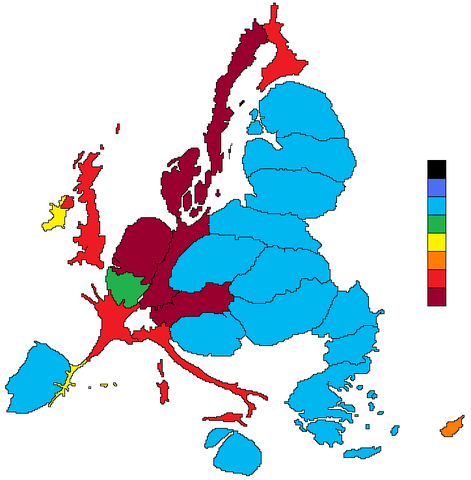The
Castor project is a submarine natural gas storage facility located in front of the eastern Iberian Peninsula coast. The idea is to store the Algerian gas inside an old oilfield cavity. At least this is what I understood (sorry, geologists).
Somehow, when the facility started working, a series of earthquakes have started to occur. At the beginning, the platform owners said it wasn't related to their activity, but now everybody agrees that it is, and the activity has stopped, but not the earthquakes.
I didn't find a nice map about the earthquakes epicenters, so I thought that D3js would be a good option to do it.
The animated map is at
my bl.ocks.org page. The explanations are in Catalan, but basically say the same as here.
Getting the data
The data about the significant earthquakes around Catalonia can be found at the
Catalan Geologic Institute web site, but the format for the reports is not very convenient to get the data, so I made this python script to get it:
# -*- coding: utf-8 -*-
#http://jramosgarcia.wordpress.com/2013/10/01/que-es-el-proyecto-castor/
import urllib
import json
import dateutil.parser
import datetime
def get_data(url):
filehandle = urllib.urlopen(url)
html = filehandle.read()
filehandle.close()
lines = html.splitlines()
for i in range(len(lines)):
if lines[i].find('Latitud') > 0:
lat = lines[i].strip().split(" ")[1].replace("º","")
if lines[i].find('Longitud') > 0:
lon = lines[i].strip().split(" ")[1].replace("º","")
if lines[i].find('mol del dia') > 0:
date = lines[i + 1].strip().replace(" >/div<","")
if lines[i].find('Hora origen') > 0:
hour = lines[i].strip().split(" ")[4]
if lines[i].find('Magnitud') > 0:
magnitude = lines[i+1].strip().split(" ")[0]
date_array = date.split("/")
hour_array = hour.split(":")
date_time = datetime.datetime(int(date_array[2]),int(date_array[1]),int(date_array[0]),int(hour_array[0]), int(hour_array[1]))
data = {'lat':lat, 'lon':lon, 'datetime': date_time.isoformat(), 'magnitude': magnitude}
return json.dumps(data)
if __name__ == "__main__":
url_list = [
'http://www.igc.cat/web/gcontent/ca/sismologia/sismescomact/comhistcat/20130910175510/comact.html',
'http://www.igc.cat/web/gcontent/ca/sismologia/sismescomact/comhistcat/20130913095842/comact.html',
'http://www.igc.cat/web/gcontent/ca/sismologia/sismescomact/comhistcat/20130918142943/comact.html',
'http://www.igc.cat/web/gcontent/ca/sismologia/sismescomact/comhistcat/20130920104607/comact.html',
'http://www.igc.cat/web/gcontent/ca/sismologia/sismescomact/comhistcat/20130924091301/comact.html',
'http://www.igc.cat/web/gcontent/ca/sismologia/sismescomact/comhistcat/20130925125029/comact.html',
'http://www.igc.cat/web/gcontent/ca/sismologia/sismescomact/comhistcat/20130929084140/comact.html',
'http://www.igc.cat/web/gcontent/ca/sismologia/sismescomact/comhistcat/20130929192416/comact.html',
'http://www.igc.cat/web/gcontent/ca/sismologia/sismescomact/comhistcat/20130930005900/comact.html',
'http://www.igc.cat/web/gcontent/ca/sismologia/sismescomact/comhistcat/20130930051316/comact.html',
'http://www.igc.cat/web/gcontent/ca/sismologia/sismescomact/comhistcat/20131001045206/comact.html',
'http://www.igc.cat/web/gcontent/ca/sismologia/sismescomact/comhistcat/20131001055709/comact.html',
'http://www.igc.cat/web/gcontent/ca/sismologia/sismescomact/comhistcat/20131002121626/comact.html',
'http://www.igc.cat/web/gcontent/ca/sismologia/sismescomact/comhistcat/20131002232928/comact.html',
'http://www.igc.cat/web/gcontent/ca/sismologia/sismescomact/comhistcat/20131003012732/comact.html',
'http://www.igc.cat/web/gcontent/ca/sismologia/sismescomact/comhistcat/20131003031301/comact.html',
'http://www.igc.cat/web/gcontent/ca/sismologia/sismescomact/comhistcat/20131004113222/comact.html',
'http://www.igc.cat/web/gcontent/ca/sismologia/sismescomact/comhistcat/20131004120323/comact.html'
]
f = open("data.json","w")
f.write("[")
json_data = ""
for url in url_list:
json_data = json_data + get_data( url ) + ", "
f.write(json_data[0:-2])
f.write("]")
f.close()
- The web pages are in the list, since the interesting reports have to be chosen one by one. It would be nice to have a better way to do it.
- Then, the get_data function just parses the text in the way that all the reports are parsed properly.The data is stored in a json file to make easier it's use from D3js.
Using D3js to visualize the data
I used
this example by Mike Bostock to create the background map. The tiles origin has been changed because the example tiles are not available at this zoom level, and to have more points of interest to situate the earthquake locations.
This is the code:
<script>
/**
Based on Mike Bostock's http://bl.ocks.org/mbostock/4150951
*/
var width = 960,
height = 500;
var projection = d3.geo.mercator()
.center([0.5491, 40.4942])
.scale(20000);
var path = d3.geo.path()
.projection(projection);
var tile = d3.geo.tile()
.scale(projection.scale() * 2 * Math.PI)
.translate(projection([0, 0]))
.zoomDelta((window.devicePixelRatio || 1) - .5);
var svg = d3.select("body").append("svg")
.attr("width", width)
.attr("height", height);
var tiles = tile();
var defs = svg.append("defs");
var magnitudeScale = d3.scale.linear().domain([2,5]).range([5,30]);
d3.json("data.json", function(error, locations) {
svg.append("g")
.selectAll("image")
.data(tiles)
.enter().append("image")
.attr("xlink:href", function(d) { return "http://" + ["a", "b", "c", "d"][Math.random() * 4 | 0] + ".tiles.mapbox.com/v3/examples.map-vyofok3q/" + d[2] + "/" + d[0] + "/" + d[1] + ".png"; })
.attr("width", Math.round(tiles.scale) + 1)
.attr("height", Math.round(tiles.scale) + 1)
.attr("x", function(d) { return Math.round((d[0] + tiles.translate[0]) * tiles.scale); })
.attr("y", function(d) { return Math.round((d[1] + tiles.translate[1]) * tiles.scale); });
svg.append("g")
.append('path')
.attr("d","m 0,0 -8.47858,-5.22254 -8.31623,5.47756 2.34696,-9.67752 -7.77927,-6.21653 9.92909,-0.75852 3.50829,-9.31953 3.78972,9.20873 9.94748,0.45679 -7.58687,6.44982 z")
.attr("stroke","black")
.attr("stroke-width",2)
.style("fill", d3.rgb(90, 90, 90))
.attr("transform", "translate("+projection([0.66879, 40.33503])[0]+","+projection([0.66879, 40.33503])[1]+")");
var locationsG = svg.append("g");
function addLocation(loc){
locationsG.append('circle')
.attr('class','location')
.attr("r", 5)
.attr("cx", projection([loc.lon, loc.lat])[0])
.attr("cy", projection([loc.lon, loc.lat])[1])
.style("fill", d3.rgb(255, 0, 0).darker(2))
.style("opacity", 0.8)
.transition()
.duration(1000)
.attr("r", magnitudeScale(loc.magnitude))
.transition()
.delay(2000)
.duration(2000)
.style("opacity",0.3);
locationsG
.append("text")
.text(loc.magnitude)
.attr("x", projection([loc.lon, loc.lat])[0] - 10)
.attr("y", projection([loc.lon, loc.lat])[1] + 5)
.attr("font-family", "sans-serif")
.attr("font-size", "12px")
.attr("fill", "black")
.style("opacity",0)
.transition()
.duration(1000)
.style("opacity",1)
.transition()
.delay(2000)
.duration(2000)
.style("opacity",0);
}
//addLocation({"lat": "40.43", "magnitude": "2.7", "lon": "0.7", "datetime": "2013-10-09T06:43:16"});
var intDate = new Date("2013-09-10T00:00:00Z");
var maxDate = new Date("2013-10-04T00:00:00Z");
var usedLocations = new Array();
var dateTitle = svg
.append("text")
.attr("id", "dataTitle")
.text(intDate.toLocaleDateString())
.attr("x", 70)
.attr("y", 20)
.attr("font-family", "sans-serif")
.attr("font-size", "20px")
.attr("fill", "black");
var interval = setInterval(function() {
dateTitle.text(intDate.toLocaleDateString());
for (i = 0; imaxDate){
clearInterval(interval);
}
}
intDate.setDate(intDate.getDate() + 1);
}, 1000);
});
























